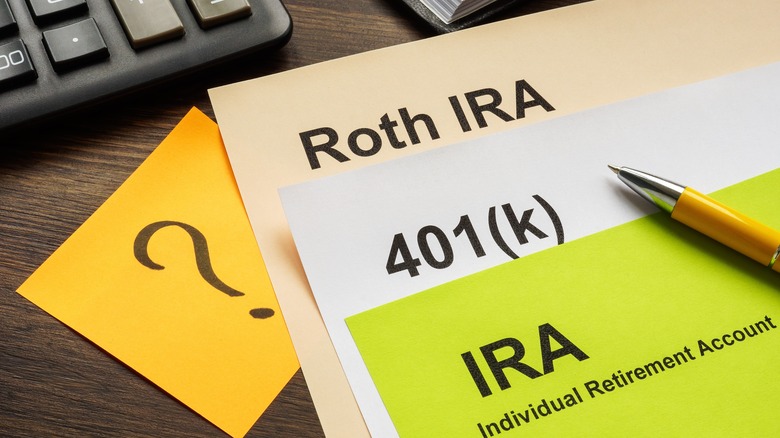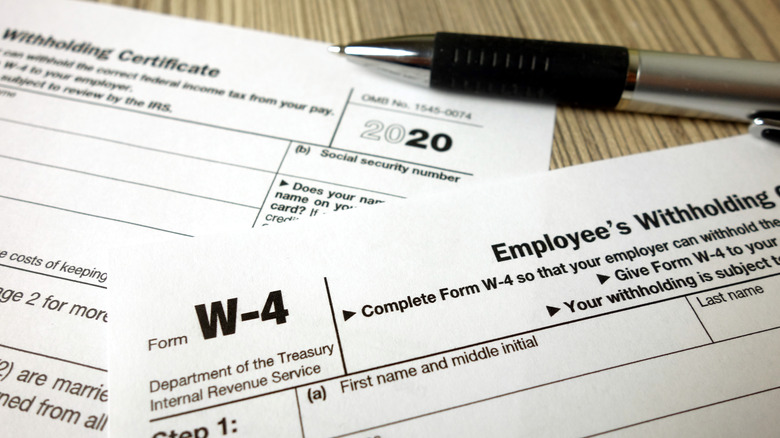10 Little-Known Ways To Get A Bigger Tax Refund
Tax season is a time when consumers start to think about their finances on a larger scale. Every year, when it comes time to file taxes, you'll likely see plenty of commercials for preparation services claiming to be able to get you the best refund possible. The reality is that anyone can leverage routine spending habits and consumer behavior to their benefit during this time. Most people just don't know how to find those seemingly hidden tax reductions. Preparation specialists understand where the best deductions hide and can help you access greater savings come tax time. Fortunately for most people, a larger savings means a bigger tax refund check.
But before you fork over a heap of money to a tax preparation specialist in the hopes of netting a larger return, it's worth looking into potential tax deductions and credits on your own. Perhaps the best-kept secret of tax season is that consumers can achieve fantastic results all on their own, without having to pay someone else to maximize their refund. These strategies are often forgotten by everyday consumers, but they can contribute to a much larger tax refund once you know how to leverage them to your benefit. On the subject of a refund check, it's worth mentioning that once your check is deposited, planning wisely with this money can set you up for greater future financial stability.
Revisit your filing status
The first thing that many people get wrong about their taxes lies in filing status. People who aren't married might immediately gravitate toward the filing umbrella of "single" without giving this a second thought. However, some unmarried individuals qualify for "head of household" status and can access a larger standard deduction and more favorable tax brackets that lower tax liabilities substantially, and on two fronts. To qualify as a head of household you must pay for more than half of the home's total expenses (i.e., groceries, rent or mortgage payments, or utility bills). You must also care for a child or some other dependent to qualify. This includes stepchildren, parents, in-laws, or grandchildren. As well, if you're caring for an elderly parent, they don't have to live with you for head of household status to apply.
Unmarried individuals aren't the only people who can utilize alternative tax filing status. Married people can file jointly, combining their taxes into one account, or file separately to utilize certain income-threshold benefits. For instance, student loan repayment plans that are determined based on income level may be more advantageous if you file separately and itemized deductions can be more potent when separating incomes — specifically in the case of large medical expense deductions. Filing status is the first thing you'll determine when doing your taxes, and giving it a bit more than just a cursory glance will set you on the best path forward.
Investigate the Earned Income Tax Credit
The Earned Income Tax Credit (EITC) is a powerful tax reduction asset designed to help low- and moderate-income families offset a sizable portion of their tax burden. The greatest benefit comes for families with more than one child, but single people also can benefit significantly from this tax reduction tool.
The EITC offers a maximum tax credit of $7,430 for those with low-to-moderate incomes and three or more children. For a married couple with three children, the Adjusted Gross Income (AGI) threshold sits at $63,398 (for single or head-of-household filers the ceiling is calculated at $56,838). This tax credit is therefore a highly valuable means of offsetting any tax liability you may face. Moreover, the Earned Income Tax Credit is refundable, which means that if you're already due a refund as a result of overpayment (or other tax-advantaged reduction strategies), applying this tax credit can drastically add to the refund you'll receive. Even so, a sizable number of eligible Americans leave this refundable credit on the table: 20% of eligible taxpayers fail to include this refundable credit in their filing every year. The eligibility requirements are straightforward and the IRS includes a simple checker tool on its website to help taxpayers figure out if they can use the credit and what they may be owed. Don't leave this free tax reduction sitting idle if you can leverage it in your favor.
Roll over credits for energy saving home improvements
When installing solar panels or conducting other energy-saving home improvements, you can write off 30% of the cost when filing your taxes. This offers an excellent way to reduce your tax burden and save a good bit of money directly after shelling out cash for a potentially sizable upgrade expense. But the tax credits for home improvements in this regard aren't refundable, meaning that some homeowners won't get to take advantage of the full 30% when filing their taxes. There's a big caveat here that many people miss, however.
Even if you can't utilize the full weight of the tax credit, it isn't necessarily lost. The credit is instead eligible to be used as a rollover, meaning if you only use half of your eligible expenses to offset your taxes in one year then the other half can be applied to the following tax year. It's easy to forget about rollover tax credits though, with all of the time and life events that take place between one tax season and the next. Remembering to include your rollover credits especially ones associated with potentially large purchases like an energy efficiency upgrade, can dramatically improve the outcome of your tax filing efforts across multiple years.
Sell stocks sitting in the red
Profits on any stocks or other assets that you sell from your investment portfolio are subject to capital gains taxes. To decrease your tax burden, prioritize selling only assets you've held for more than a year. This means that the profits will be assessed at the long-term capital gains rates rather than short-term ones. If you strategize particularly well with your stock sales, you may even qualify for a zero-tax rate depending on the amount you sell and other income factors. One way to offset any capital gains tax you may be on the hook to pay, however, is to sell assets that are underperforming as well as those that have achieved quality growth. Selling stocks that have lost money reduces your overall profit figure and will therefore reduce the amount of tax you owe on your overall profits from the sales. It's important to spend a good deal of time strategizing before selling anything in the red, however.
Because the first long-term capital gains tax bracket is 0%, you may not be required to pay anything under certain circumstances. This means that selling underperforming assets won't help you at all in this regard. Alternatively, you might be selling a good deal of assets that will ultimately net a higher rate because of other income factors. In this case, rebalancing your portfolio to shed some deadweight can act as a cull on poorly performing assets and a tax benefit at the same time.
Contribute to your IRA
Your traditional IRA account is a tax-advantaged retirement asset that offers value in a number of ways. Most prominently, an IRA provides an immediate tax shelter over dollars you wish to earmark for your later years. Any contributions you make to your IRA are added to the account before income tax is assessed on your earnings. This means that you can shield money from the highest tax thresholds you're likely to pay throughout your working years. Once you retire, these funds are taxed but only as you withdraw them from the account. The result is a unique ability to dictate the drawdown rate and control the level of taxable income you are liable for as a result.
But, investing in your IRA account acts as an above-the-line deduction, too. This results in an ability to reduce your adjusted gross income without added rules or restrictions as is the case with other tax burden-reducing approaches — such as the itemized deduction. The result is a retirement savings account that provides a wealth of tax benefits across the board. Unfortunately, many Americans aren't saving enough, or perhaps even at all, for their retirement and fail to fully realize the benefits of this kind of savings account.
Understand your childcare kickbacks
The government is quite generous with deductions and credits surrounding dependent children. The child tax credit is worth up to $2,000 per dependent child and dependent care credits provide up to $6,000 when claiming two or more qualifying people on your taxes.
This isn't to say that someone looking to transform their tax burden should seek to have children specifically and solely for tax planning reasons, but rather that children act as invaluable financial boosters come tax time — unlike their financial effect throughout the rest of the year. Indeed, these tax credits aren't likely to offset the actual expense of caring for a child: Estimates suggest that raising a child from birth to the age of majority costs roughly $240,000. Even so, it's nice to know that families can take advantage of sizable tax breaks to help care for their young members.
In another vein, the Child and Dependent Care Tax Credit is an additional tax offset opportunity that allows you to claim credit for qualified care expenses (ranging between 20% and 25% of the total cost and up to $3,000 for one dependent and $6,000 for multiple). This tax credit also extends to adult family members who require financial and physical support as a result of mental or physical difficulties.
Claim the adoption credit if eligible
Another tax credit that likely effects more people than you might expect covers adoption. Around 5 million Americans alive today were adopted. While the percentage of families that have adopted a child linger in the single digits, you may fit into this category. Adoptive parents have access to a range of tax benefits concerning the child they've so generously opted to bring into their family.
This credit is non-refundable but offers up to $15,950 in income adjustment potential. For those with a lower tax liability figure, the credit is offered with a five-year rollover window. This means that you can apply the remaining credit benefit to the following year's tax calculation. The adoption credit seeks to defray the cost of adopting a child — something that can cost up to around $50,000 in some circumstances. Taxpayers can't claim this tax credit concerning the adoption of step-children (a spouse's children with another person), but your partner's contributions (either a spouse or any other domestic partnership) toward the adoption of a child under the age of 18 can count toward these qualified expenses. Adoption expenses that can be credited back include court and attorney's fees, travel expenses, adoption fees, and any other costs associated with the adoption process.
Remember that self-employment expenses count generously in your favor
Self-employment is a major boon come tax time. It might be a little stressful to manage the responsibility of your working schedule and earnings potential, but working for yourself ultimately comes with many opportunities, including a rake of tax benefits.
Self-employed individuals are able to write off plenty of expenses, including office supplies and tools required for their work: Power tools for contractors, printers and computers for the nondescript "office worker," and all kinds of equipment in between for anyone fitting the designation. You can write off vehicle expenses and transportation costs while driving for work, rent for your office space, and even fringe benefits like gym memberships or childcare assistance. Self-employed workers are even able to take deductions for their salary and retirement savings contributions, making this type of arrangement a great way to leverage tax time heavily in your favor. If you don't work in a traditional employer-employee relationship, organizing your professional life in the form of a small business (or sole proprietorship in the event of a solo, freelance sort of venture) can open up a world of possibilities for you come tax time.
Leverage federal EV tax credits
Another great way to reduce your tax burden is by leveraging the federal government's EV purchasing incentive. There are over a dozen EVs that are eligible for federal tax credits in 2024, with a number of them yielding the maximum tax break of $7,500. For buyers in the market for a new car, looking at electric vehicles remains a great option with larger tax-advantaged ramifications coming into play.
An EV can lend itself to a massive improvement in your transportation costs. Some luxury models are certainly going to be more expensive than similarly styled vehicles powered by a traditional engine, but EVs have become exceedingly affordable in recent years, on the whole. Average prices continue to drop among EVs, and some models can be found new for less than $30,000. Coupled with solar paneling at home and perhaps included charging capabilities at the office, you may be looking at zero added expense to operate the vehicle daily — aside from routine maintenance, that is. Adding in the major tax break that many new EVs provide, opting for a greener alternative in your daily method of transportation can add myriad financial benefits to your yearly fiscal forecast.
Consider your W-4 status and withholding options
Finally, the W-4 you completed when you started working at your current job might offer a means of upgrading your tax refund each year. However, it's important to remember that any changes made to your W-4 won't alter your overall tax burden. Instead, it shifts how much the government will take off the top of each paycheck in an effort to accurately gauge that burden. By claiming credits (like dependent credits) on your W-4, the government will take less from your monthly paychecks, making your refund smaller and your month-to-month salary larger.
It's possible to adjust your W-4 so that a larger withholding figure is taken off the top, ultimately to be returned to you when you file your taxes each year. Making this adjustment might help you budget for the long term a little more effectively. For those who have trouble saving every month, maximizing the government's withholding could provide you with a quasi-savings account that is returned to you each spring when you complete your taxes. No matter how you position yourself in this regard, it's important to note that your tax burden won't change, and a larger refund simply means that the government held onto more of your money throughout the year.










